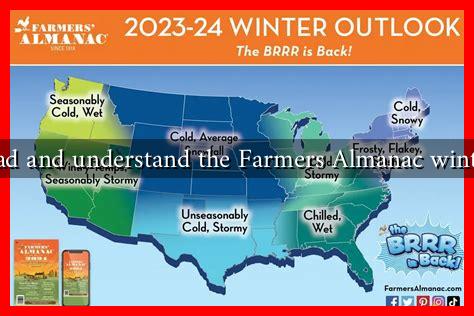-
Table of Contents
How to Read and Understand the Farmers Almanac Winter Forecast
The Farmers Almanac has been a trusted source for weather predictions and agricultural advice since its inception in 1818. Each year, it releases a winter forecast that many people rely on for planning their seasonal activities. However, understanding how to read and interpret this forecast can be challenging. This article will guide you through the process, ensuring you can make the most of the information provided.
What is the Farmers Almanac?
The Farmers Almanac is a publication that offers long-range weather forecasts, gardening tips, and various articles on topics ranging from astronomy to cooking. Its weather predictions are based on a secret formula that considers solar cycles, planetary positions, and historical weather patterns.
. The Almanac claims an accuracy rate of about 80%, making it a popular resource for farmers, gardeners, and outdoor enthusiasts alike.
Understanding the Winter Forecast
The winter forecast in the Farmers Almanac is typically divided into several key components:
- Temperature Predictions: The Almanac provides a general overview of expected temperatures for each month of winter.
- Precipitation Forecasts: This section outlines the likelihood of snow, rain, and other forms of precipitation.
- Regional Breakdown: The forecast is often divided by regions, allowing readers to find specific information relevant to their area.
- Notable Weather Events: The Almanac may highlight significant weather events, such as storms or cold snaps, that are expected during the winter months.
How to Read the Forecast
To effectively read the Farmers Almanac winter forecast, follow these steps:
- Identify Your Region: The first step is to locate the section of the forecast that pertains to your geographical area. The Almanac divides the U.S. into several regions, each with its own specific predictions.
- Focus on Temperature and Precipitation: Pay close attention to the temperature and precipitation sections. These will give you a general idea of what to expect throughout the winter.
- Look for Patterns: The Almanac often highlights trends, such as a colder-than-average winter or increased snowfall. Understanding these patterns can help you prepare accordingly.
- Consider Historical Context: The Almanac often references historical weather data. Comparing current predictions with past winters can provide valuable insights into what might happen.
Case Studies: Real-World Applications
Many individuals and businesses use the Farmers Almanac to plan their winter activities. For example:
- Agricultural Planning: Farmers often rely on the Almanac to determine the best times for planting and harvesting crops. A farmer in the Midwest might use the winter forecast to decide when to prepare fields for spring planting.
- Travel Planning: Families planning winter vacations can use the forecast to choose destinations with favorable weather conditions. For instance, if the forecast predicts heavy snowfall in one region, travelers might opt for a milder climate elsewhere.
- Home Maintenance: Homeowners can use the forecast to prepare for potential winter storms. If heavy snow is predicted, they might take steps to winterize their homes or stock up on supplies.
Statistics and Accuracy
While the Farmers Almanac claims an accuracy rate of around 80%, it’s essential to approach these predictions with a critical eye. A study conducted by the National Oceanic and Atmospheric Administration (NOAA) found that long-range forecasts can be hit or miss, depending on various factors such as climate variability and local conditions. Therefore, it’s wise to use the Almanac as one of several resources when planning for winter.
Conclusion
Understanding the Farmers Almanac winter forecast can significantly enhance your ability to prepare for the season ahead. By focusing on regional predictions, temperature and precipitation forecasts, and historical context, you can make informed decisions about agriculture, travel, and home maintenance. While the Almanac is a valuable tool, remember to complement it with other weather resources for the most accurate planning. For more information, you can visit the official Farmers Almanac website at FarmersAlmanac.com.





